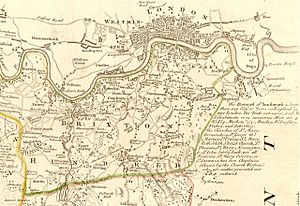Hundred of Brixton facts for kids
| Brixton | |
 |
|
| Geography | |
| Status | hundred |
| 1831 area | 30,400 acres (123 km2) |
| 1887 area | 29,714 acres (120 km2) |
| HQ | Brixton |
| History | |
| Created | in antiquity |
| Abolished | 1889 |
| Succeeded by | various, see text |
Quick facts for kids Demography |
|
|---|---|
| 1861 population | 409,504 |
| 1887 population | 825,155 |
| Subdivisions | |
| Type | Parishes |
| Units |
|
The Brixton Hundred was a special area in England that existed for many centuries. It was like a big district made up of several smaller areas called parishes. People used these hundreds for important meetings and to collect taxes from large estates.
This historic area was located in the northeast part of Surrey, England. Over time, the city of London grew so much that it completely covered the Brixton Hundred. Today, the name "Brixton" usually refers to a specific part of London.
The land that was once the Brixton Hundred now includes several London boroughs: Southwark, Lambeth, and Wandsworth. It also covers parts of Lewisham, Merton, and Richmond upon Thames.
Contents
History of Brixton Hundred
What's in a Name?
The name "Brixton" first appeared in records around the year 1062. It was written as Brixiges stan, which means "stone of Beorhtsige." Beorhtsige was likely an important person. His stone might have been where early meetings for the hundred took place.
Some historians think this stone was located where the areas of Streatham, Clapham, and Lambeth met. Later, a place on Brixton Hill was used for the hundred's gallows. A gallows was a structure used for hangings in the past. Brixton Hill was known by names like Bristowe Causeway long before the modern Brixton area developed. Brixton Prison, which was originally called the Surrey House of Correction, opened there in 1820.
Where Was Brixton Hundred?
The Brixton Hundred had clear borders. To the north, it met the City of London and the Ossulstone hundred of Middlesex. The tidal River Thames formed this northern boundary.
Within Surrey, the Brixton Hundred was bordered by the Wallington hundred to the south. To the west, it met the Kingston hundred. On the eastern side, it shared a border with the Blackheath hundred, which was part of Kent.
In 1831, the hundred covered about 30,400 acres (123 km2). By 1861, its population was recorded as 409,504 people. In 1887, the area was slightly smaller at 29,714 acres (120 km2), but its population had grown to 825,155.
Smaller Parts of the Hundred
The Brixton Hundred was made up of several parishes. These included Battersea (which had a separate part called Penge), Bermondsey (which later included Rotherhithe), Camberwell, Lambeth, Newington, and Streatham.
Other parishes were Barnes, Merton, Mortlake (which later included Wimbledon and Putney), Tooting Graveney, and Wandsworth. It also included a part of Deptford known as Hatcham, which was a manor and later a small church area around 1800.
In 1851, the hundred was divided into two main parts:
- The Eastern division was about 22,186 acres (90 km2) and had 314,815 people. It included Bermondsey, Camberwell, Clapham, Hatcham, Lambeth, Newington, Penge, Rotherhithe, and Streatham.
- The Western division was about 7,699 acres (31 km2) and had 9,552 people. It included Barnes, Battersea, Merton, Mortlake, Putney, Tooting Graveney, Wandsworth, and Wimbledon.
Inside the hundred was the old town of Southwark. This area gained special rights in 1295. It first included the parishes of St George the Martyr, St Olave, St Margaret, and St Mary.
How the Hundred Changed
Over time, the old system of hundreds became less important for managing local areas. New types of local government bodies started to take over.
Most of the Brixton Hundred became part of the Metropolitan Police District in 1829. This happened because of the Metropolitan Police Act 1829. The rest of the hundred joined this police district in 1840.
In 1855, most of the hundred also came under the control of the Metropolitan Board of Works. This was due to the Metropolis Management Act 1855. The parts not included were Barnes, Merton, Mortlake, and Wimbledon.
The hundred system almost completely disappeared when most of the area became part of the County of London in 1889. Again, Barnes, Merton, Mortlake, and Wimbledon were the exceptions. In 1894 and 1900, all local government duties were replaced by a new system of uniform districts. Finally, in 1965, the entire area became part of Greater London, and the districts were replaced by the London boroughs we know today.

